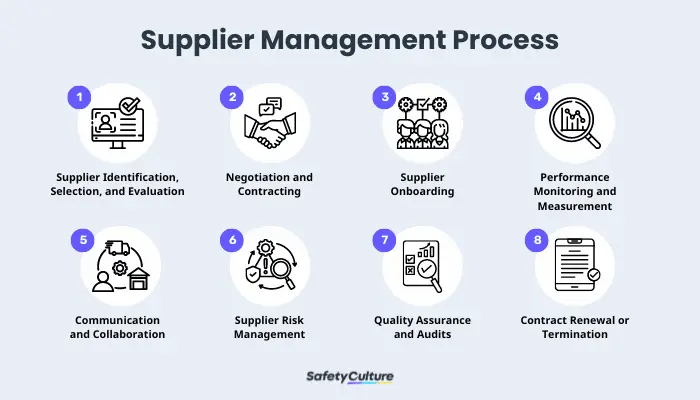What is Supplier Management?
Supplier management, also known as Supplier Relationship Management (SRM), is the strategic process of overseeing and nurturing relationships with external suppliers who provide goods, services, or components to a business or organization. It involves a range of activities aimed at optimizing the value derived from supplier partnerships while minimizing risks and ensuring the smooth functioning of the supply chain.
Why is Supplier Management Important?
The overall goal of supplier management is to establish proper relationships, manage requirements, and communicate clearly with suppliers to ensure the smooth running of an organization.
Apart from those, this strategic process is of paramount importance for the following reasons:
- Supply Chain Resilience
- Product and Service Quality
- Cost Efficiency
- Innovation and Competitive Advantage
- Streamlined Operations
- Flexibility and Adaptability
- Sustainability and Ethical Practices
- Collaboration and Knowledge Sharing
- Long-Term Partnerships
- Customer Satisfaction
Key Features of Effective Management of Suppliers
Being aware of the key features of effective supplier management has a profound impact it has on an organization’s overall supply chain performance and success. These serve as guiding principles that shape the way organizations engage with their suppliers, leading to a range of benefits that apply to every aspect of operations.
Here are some of the common features of effective supplier management that contribute to successful supplier relationships and optimized supply chain operations:
- Strategic Alignment, Collaboration, and Communication
- Supplier Performance Measurement and Development
- Technology Integration
- Supplier Segmentation and Diversification
- Crisis Management Planning
- Contract Flexibility and Pricing Transparency
- Alignment of Values
- Regular Reviews and Audits
- Conflict Resolution
- Executive Support
What are the Different Types of Supplier Management Models?
An organization can approach its supplier management system uniquely to suit its goals, business needs, and products or services. This is where various models can be considered to ensure targeted initiatives and effective implementation.
The following are the major classifications of how organizations can source their products, components, or services:
Single-Sourcing
Single-sourcing is a supplier management model where an organization relies on a single supplier. This approach can offer benefits, such as simplified communication, the potential for better negotiation leverage, and streamlined processes.
However, it also comes with inherent risks, as any issues with a single supplier can lead to supply chain disruptions. To mitigate such risks, organizations employing this model must have contingency plans in place.
Multiple-Sourcing
The multiple-sourcing model, on the other hand, involves an organization procuring goods or services from multiple suppliers. By working with several suppliers, organizations can better navigate supply disruptions, quality issues, and changing market dynamics.
However, multiple-sourcing can complicate coordination, negotiation, and communication efforts with multiple stakeholders.
Virtual Organization
This model is a more complex approach involving collaborating with suppliers and partners across different geographical locations, often facilitated by advanced communication technologies and digital platforms. This enables organizations to tap into global expertise, resources, and capabilities while minimizing the need for physical infrastructure.
What Does the Process Involve?
Effectively managing an organization’s suppliers involves a series of steps and activities that require a strategic outlook, effective communication, and continuous evaluation to ensure successful supplier partnerships, supply chain resilience, and the achievement of organizational goals.
Here’s an overview of the typical supplier management process:

Supplier Management Process
1. Supplier Identification, Selection, and Evaluation
The supplier selection process begins with identifying potential suppliers that align with the organization’s needs and strategic goals. Various criteria (e.g., quality, cost, ethical considerations, production capacity) are evaluated. Then, a shortlist of suitable suppliers is created.
2. Negotiation and Contracting
Once a quality supplier is identified, negotiations take place to establish terms, conditions, pricing, delivery schedules, and other contractual details. The finalized agreement outlines expectations, responsibilities, and performance metrics.
3. Supplier Onboarding
After the contract signing, the supplier is onboarded into the organization’s systems. This involves sharing relevant information, setting up communication channels, and clarifying roles and responsibilities.
3. Supplier Onboarding
After the contract signing, the supplier is onboarded into the organization’s systems. This involves sharing relevant information, setting up communication channels, and clarifying roles and responsibilities.
4. Performance Monitoring and Measurement
Throughout the relationship, Key Performance Indicators (KPIs) are established to measure supplier performance. Regularly tracking these metrics ensures adherence to quality, delivery, and other contractual obligations.
5. Communication and Collaboration
Open and transparent communication is maintained with suppliers to address any concerns, provide updates, and collaborate on improvements or innovations. Also, feedback is shared to encourage continuous improvement.
6. Supplier Risk Management
Risks associated with the supplier relationship and broader supply chain are identified and evaluated. To support these and address potential disruptions, mitigation strategies, including contingency plans, must be developed.
7. Quality Assurance and Audits
Periodic quality audits should be conducted to verify that suppliers meet established quality standards. Doing these ensures compliance with regulations, identifies areas for improvement, and maintains consistent product or service quality.
8. Contract Renewal or Termination
Contracts are also periodically reviewed and renewed, often based on supplier performance and evolving business needs. As needed, the process of contract termination is managed with minimal disruption to the supply chain and through the help of a well-maintained supplier management database.
Strategies
To complement your efforts in ensuring a smooth process in building and managing relationships with your organization’s suppliers, here are some supplier management strategies and best practices you can implement:
- Foster collaboration with key suppliers to drive mutual innovation, process improvement, and problem-solving through regular meetings, joint initiatives, and information sharing.
- Maintain a diversified supplier base to reduce dependence on a single source and avoid risks associated with disruptions and shortages from only one supplier.
- Establish clear performance metrics and KPIs for suppliers and incentivize high performance through rewards and penalties.
- Develop comprehensive risk assessment, mitigation, and contingency plans to minimize negative impact on the business.
- Prioritize working with suppliers that adhere to ethical and sustainable business practices, especially those with Environmental, Social, and Governance (ESG) commitments that align with your organization’s values.
- Focus on building long-term partnerships with suppliers, leading to more stable and collaborative relationships.
- Leverage data and analytics to gain insights into supplier performance, trends, and opportunities for improvement.
Create Your Own Supplier Management Checklist
Eliminate manual tasks and streamline your operations.
Get started for FREEChallenges
Now, what are the challenges of supplier management? Of course, there may be unforeseen hurdles along the way. So, it’s best to be informed of these possibilities to help mitigate their impact:
- Supply Chain Disruptions
- Dependency on Key Suppliers
- Quality Control Issues
- Communication Breakdowns
- Unpredictable Market Changes
- Unforeseen Cost Increases
- Lack of Executive Buy-In
- Compromised Data Security and Privacy
Training
Effective supplier management involves strict adherence to standards organizations set for their processes. To ensure everyone across the board is aligned with best practices, training must be implemented and provided as a core initiative.
Training equips individuals with the necessary knowledge, skills, and tools to manage supplier relationships, ensure supply chain resilience, and drive successful outcomes. Apart from those, here are other examples of the areas that can be covered in comprehensive supplier management training programs:
- Supplier Relationship Skills – e.g., communication, negotiation, and conflict resolution skills
- Negotiation Techniques – empowers procurement and supplier management professionals to secure favorable terms and agreements with suppliers
- Risk Management – enables individuals to identify potential disruptions and develop contingency plans
- Supplier Evaluation – helps effectively evaluate and qualify suppliers based on reasonable criteria
- Performance Measurement – helps track supplier performance and ensure contractual compliance
- Data Analytics and Technology – enhances visibility, data-driven decision-making, and process efficiency
- Crisis Management – prepares teams to effectively handle supply chain and supplier crises
- Regulatory Compliance – ensures that individuals understand legal requirements and compliance standards relevant to supplier relationships
- Change Management – helps teams adapt to changes effectively
FAQs About Supplier Management
Supplier management is a collaborative effort that involves multiple roles within an organization to ensure comprehensive and effective management of supplier relationships. Here are some of the key stakeholders responsible for it:
- Procurement or Purchasing Department
- Supplier Relationship Managers
- Risk Management Team
- Finance and Legal Departments
- Sustainability and Ethical Compliance Officers
- Operations and Manufacturing Teams
- Innovation and Research Teams
- Executive Leadership
- IT and Technology Teams
Supply management addresses the holistic oversight of the entire supply chain, while supplier management specifically refers to the strategic management of relationships with external suppliers or vendors to optimize sourcing, procurement, and collaboration efforts. Both are critical for organizations to achieve efficient and effective supply chain operations that meet customer demands and drive business success.
Yes, supplier management is an integral part of the broader procurement process. Procurement encompasses a range of activities involved in sourcing and acquiring goods, services, or raw materials required for an organization’s operations. Supplier management is a specific subset of procurement that focuses on the strategic management of relationships with external suppliers who provide these goods, services, or components.
By proactively cultivating strong relationships with suppliers, organizations can become resilient and better equipped to anticipate and manage potential disruptions arising from factors such as market fluctuations, geopolitical events, or natural disasters. This then translates into a consistent supply of goods and services, safeguarding production schedules and meeting customer demands even in the face of challenges.




